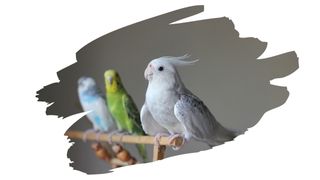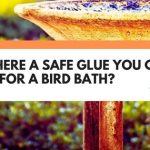Making a birdhouse is a fun woodworking project. It’s a great way to help out local wildlife, giving birds a safe place to nest.
And, natural solid bird-safe woods are a great material for making perches and birdhouses from.
But, what about using a manufactured wood, such as plywood? Is this layered lumber truly safe to use around birds?
Well, in this post, you’ll discover what really goes into the manufacture of plywood. And keep reading to find out what this all means for your birds health and safety…

This post may contain affiliate links to products that we receive a commission for (at no additional cost to you). Learn more here.
What Is Plywood Actually Made Of?
Well, plywood is an engineered material, which means that it isn’t a natural wood.
Instead, plywood is made up of multiple thin wooden plies. And those plies are placed atop one another, at alternating angles.
However, the particular wood used to make plywood can vary widely. Various types of wood, from Douglas Fir to Maple to Birch, have been used to make this material.
Still, one thing all plywood sheets have in common, is the fact that an adhesive is used to make them. And when it comes to a typical plywood sheet, that adhesive will contain formaldehyde resins called phenol-formaldehyde.
And Why Is Phenol-Formaldehyde Adhesive So Toxic?
It all boils down to the fact that formaldehyde itself is incredibly dangerous. If it is ingested in large enough amounts, it is poisonous — both to humans and pets.
Even formaldehyde vapor can cause severe respiratory problems. And in liquid form, it can burn our skin.
Related Post: Is Teak Oil Safe For Birds? (How To Safely Finish A Bird House)
Does That Mean Plywood Can Release Toxic Fumes?
Solvent-based substances, (such as glues and paint), all go through something called ‘off-gassing’. Off-gassing refers to the fumes released from finishes, glues, and paint, as they dry.
It can take just a few hours for wood glues or paints to dry to the touch. However — as anyone who has painted a room can attest — it can take weeks for the fumes to clear up.
And the same goes for phenol-formaldehyde based glues. It can take up to 24 months for this glue to stop releasing significant amounts of fumes into the air.
Nevertheless, store-bought plywood will have already had time to sit and dry out. Which means that formaldehyde off-gassing shouldn’t be all that severe with this plywood.
But, even if off-gassing isn’t an issue, ingesting any plywood at all can still bring harm to birds. Why? Well because…
…Treated Plywood Is Full Of Chemicals
Plywood is not rot-resistant. So, more often than not, a sheet of plywood will have been ‘treated’ with rot-resisting chemicals.
And these chemicals are anti-fungal wood preservatives. Their job involves fighting off the bacteria responsible for wood rot.
However, the chemicals infused into treated plywood — such as Chromated copper arsenate (CCA) — are toxic. Certainly much too toxic to risk being ingested by birds.
Now, having said all that, you can still find and purchase untreated plywood.
But, without a wood preserving chemical treatment, untreated plywood will rot away fairly quickly. Especially if moisture or humidity gets into it.
Related Post: Is There A Type Of Plywood That Doesn’t Warp? (Solved!)
Is There A Formaldehyde-Free Plywood I Can Use Instead?
There are certain specialized formaldehyde-free plywood’s you can buy. And they are marked as NAF (No Added Formaldehyde) Plywood.
These plywood sheets are glued together using a natural-alternative adhesive, instead of formaldehyde-based glues.
That’s Great! So, I Can Use NAF Plywood Instead, Right?
Not quite.
Sure, NAF Plywood completely does away with toxic wood glues. But, it replaces them with a soy-based adhesive instead.
Which is great news, until you realize that Soy contains something called phytoestrogens. Phytoestrogens are plant-based compounds, but they can cause hormone imbalances in both humans and birds.
So, if your pet likes to chew on wood — and you suspect they may also chew that plywood — then this is another possible safety risk.
Now, maybe this is all acting with an over-abundance of caution. Maybe avoiding even NAF plywood is simply being a little too careful.
But, it’s always better to err on the side of caution, when it comes to pet safety.
Related Post: Is There A Bird Safe Paint For Wood? (+ Why VOC’s Are The Real Problem)
So Does That Mean Plywood Is Not Safe For Birds?
Well, the safest type of wood you can use is always going to be untreated natural solid wood. What’s more, that wood must come from a tree species that isn’t harmful to birds.
Which means that plywood is not a bird-safe material.
In fact, you can go one step further and avoid all manufactured woods — since they often contain toxic chemical glues.
What Type Of Wood Is Safe For Birds? For a full list of safe natural wood types for parrots, check out The Natural Bird Company’s guide here.
To Wrap Up, Here Are The 3 Key Takeaways From This Post…
- 1). Plywood is a manufactured wood, often made using formaldehyde-based glues.
- 2). Plywood also tends to be treated with chemical wood preservatives.
- 3). When it comes to the health of our pets, it’s better to be safe than sorry. So, avoid using plywood altogether.
References:
Treated Wood In The Landscape | Home & Garden Information Center
The pros and cons of phytoestrogens | National Library of Medicine
Soy and phytoestrogens | National Library of Medicine

